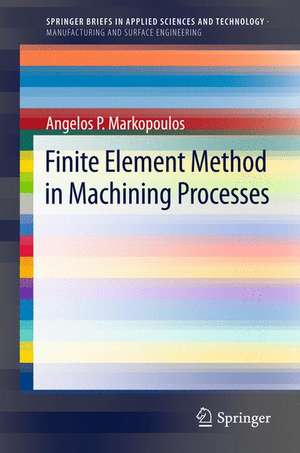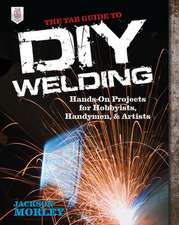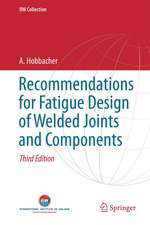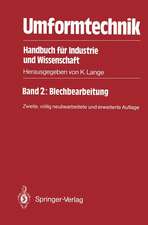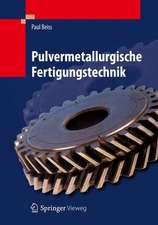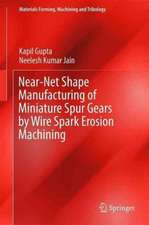Finite Element Method in Machining Processes: SpringerBriefs in Applied Sciences and Technology
Autor Angelos P. Markopoulosen Limba Engleză Paperback – 4 aug 2012
A discussion on FEM, formulations, and techniques currently in use is followed up by machining case studies. Orthogonal cutting, oblique cutting, 3D simulations for turning and milling, grinding, and state-of-the-art topics such as high speed machining and micromachining are explained with relevant examples. This is all supported by a literature review and a reference list for further study.
As FEM is a key method for researchers in the manufacturing and especially in the machining sector, Finite Element Method in Machining Processes is a key reference for students studying manufacturing processes but also for industry professionals.
Din seria SpringerBriefs in Applied Sciences and Technology
-
 Preț: 380.29 lei
Preț: 380.29 lei - 17%
 Preț: 360.34 lei
Preț: 360.34 lei - 20%
 Preț: 386.12 lei
Preț: 386.12 lei -
 Preț: 380.07 lei
Preț: 380.07 lei -
 Preț: 377.95 lei
Preț: 377.95 lei -
 Preț: 382.32 lei
Preț: 382.32 lei -
 Preț: 376.59 lei
Preț: 376.59 lei -
 Preț: 379.09 lei
Preț: 379.09 lei -
 Preț: 378.12 lei
Preț: 378.12 lei - 20%
 Preț: 293.83 lei
Preț: 293.83 lei -
 Preț: 344.90 lei
Preț: 344.90 lei -
 Preț: 321.36 lei
Preț: 321.36 lei -
 Preț: 264.79 lei
Preț: 264.79 lei -
 Preț: 344.90 lei
Preț: 344.90 lei -
 Preț: 356.46 lei
Preț: 356.46 lei -
 Preț: 382.95 lei
Preț: 382.95 lei -
 Preț: 355.66 lei
Preț: 355.66 lei -
 Preț: 479.67 lei
Preț: 479.67 lei -
 Preț: 415.18 lei
Preț: 415.18 lei -
 Preț: 444.52 lei
Preț: 444.52 lei - 20%
 Preț: 301.86 lei
Preț: 301.86 lei -
 Preț: 409.43 lei
Preț: 409.43 lei - 20%
 Preț: 322.17 lei
Preț: 322.17 lei -
 Preț: 355.49 lei
Preț: 355.49 lei - 15%
 Preț: 462.51 lei
Preț: 462.51 lei -
 Preț: 377.18 lei
Preț: 377.18 lei -
 Preț: 355.93 lei
Preț: 355.93 lei -
 Preț: 382.95 lei
Preț: 382.95 lei -
 Preț: 378.12 lei
Preț: 378.12 lei -
 Preț: 378.12 lei
Preț: 378.12 lei -
 Preț: 380.07 lei
Preț: 380.07 lei -
 Preț: 380.07 lei
Preț: 380.07 lei - 20%
 Preț: 326.28 lei
Preț: 326.28 lei -
 Preț: 312.68 lei
Preț: 312.68 lei -
 Preț: 356.43 lei
Preț: 356.43 lei -
 Preț: 412.30 lei
Preț: 412.30 lei - 20%
 Preț: 225.31 lei
Preț: 225.31 lei -
 Preț: 378.12 lei
Preț: 378.12 lei -
 Preț: 376.59 lei
Preț: 376.59 lei -
 Preț: 195.87 lei
Preț: 195.87 lei -
 Preț: 376.22 lei
Preț: 376.22 lei - 20%
 Preț: 324.64 lei
Preț: 324.64 lei - 20%
 Preț: 288.73 lei
Preț: 288.73 lei -
 Preț: 377.57 lei
Preț: 377.57 lei -
 Preț: 261.91 lei
Preț: 261.91 lei -
 Preț: 381.98 lei
Preț: 381.98 lei -
 Preț: 273.64 lei
Preț: 273.64 lei -
 Preț: 410.87 lei
Preț: 410.87 lei -
 Preț: 379.68 lei
Preț: 379.68 lei -
 Preț: 374.30 lei
Preț: 374.30 lei
Preț: 348.72 lei
Nou
Puncte Express: 523
Preț estimativ în valută:
66.75€ • 72.53$ • 56.11£
66.75€ • 72.53$ • 56.11£
Carte tipărită la comandă
Livrare economică 16-22 aprilie
Preluare comenzi: 021 569.72.76
Specificații
ISBN-13: 9781447143291
ISBN-10: 1447143299
Pagini: 104
Ilustrații: VIII, 92 p. 27 illus.
Dimensiuni: 155 x 235 x 10 mm
Greutate: 0.15 kg
Ediția:2013
Editura: SPRINGER LONDON
Colecția Springer
Seriile SpringerBriefs in Applied Sciences and Technology, Manufacturing and Surface Engineering
Locul publicării:London, United Kingdom
ISBN-10: 1447143299
Pagini: 104
Ilustrații: VIII, 92 p. 27 illus.
Dimensiuni: 155 x 235 x 10 mm
Greutate: 0.15 kg
Ediția:2013
Editura: SPRINGER LONDON
Colecția Springer
Seriile SpringerBriefs in Applied Sciences and Technology, Manufacturing and Surface Engineering
Locul publicării:London, United Kingdom
Public țintă
ResearchCuprins
Machining mechanics and orthogonal cutting model.- FEM and manufacturing technology.- Special features of modeling.- Advanced modeling.- Results and discussion.
Notă biografică
Angelos P. Markopoulos is a mechanical engineer. He received his Ph.D. from the Manufacturing Technology Division of the National Technical University of Athens in 2006. His research includes topics such as precision and ultraprecision machining processes with special interest in high speed hard machining, grinding, micromachining and nanotechnology. These subjects are studied experimentally as well as through numerical and artificial intelligence methods like the Finite Element Method and Neural Networks. He is the author of more than 30 papers in journals, conferences and book chapters on the above mentioned areas. He is member of the Editorial Review Board and Reviewer for several scientific journals. Parallel to his research activities he has been teaching in various Universities of Greece including the National Technical University of Athens, the University of Thessaly, the School of Pedagogical and Technological Education, the Hellenic Air Force Academy and the Hellenic Navy. In 2011 he was elected lecturer in the National Technical University of Athens.
Textul de pe ultima copertă
Finite Element Method in Machining Processes provides a concise study on the way the Finite Element Method (FEM) is used in the case of manufacturing processes, primarily in machining. The basics of this kind of modeling are detailed to create a reference that will provide guidelines for those who start to study this method now, but also for scientists already involved in FEM and want to expand their research.
A discussion on FEM, formulations and techniques currently in use is followed up by machining case studies. Orthogonal cutting, oblique cutting, 3D simulations for turning and milling, grinding, and state-of-the-art topics such as high speed machining and micromachining are explained with relevant examples. This is all supported by a literature review and a reference list for further study.
As FEM is a key method for researchers in the manufacturing and especially in the machining sector, Finite Element Method in Machining Processes is a key reference for students studying manufacturing processes but also for industry professionals.
A discussion on FEM, formulations and techniques currently in use is followed up by machining case studies. Orthogonal cutting, oblique cutting, 3D simulations for turning and milling, grinding, and state-of-the-art topics such as high speed machining and micromachining are explained with relevant examples. This is all supported by a literature review and a reference list for further study.
As FEM is a key method for researchers in the manufacturing and especially in the machining sector, Finite Element Method in Machining Processes is a key reference for students studying manufacturing processes but also for industry professionals.
Caracteristici
Presents special software applied in this area and explains all the used formulations through examples and bibliography Includes examples not only for orthogonal cutting as it is accustomed to, but also for oblique cutting, 3D simulations for turning, milling and sections on High Speed Machining, Hard Turning and micromachining simulation and their special features Focuses on special features a researcher has to face when using this method, e.g. the modeling of friction Includes supplementary material: sn.pub/extras
